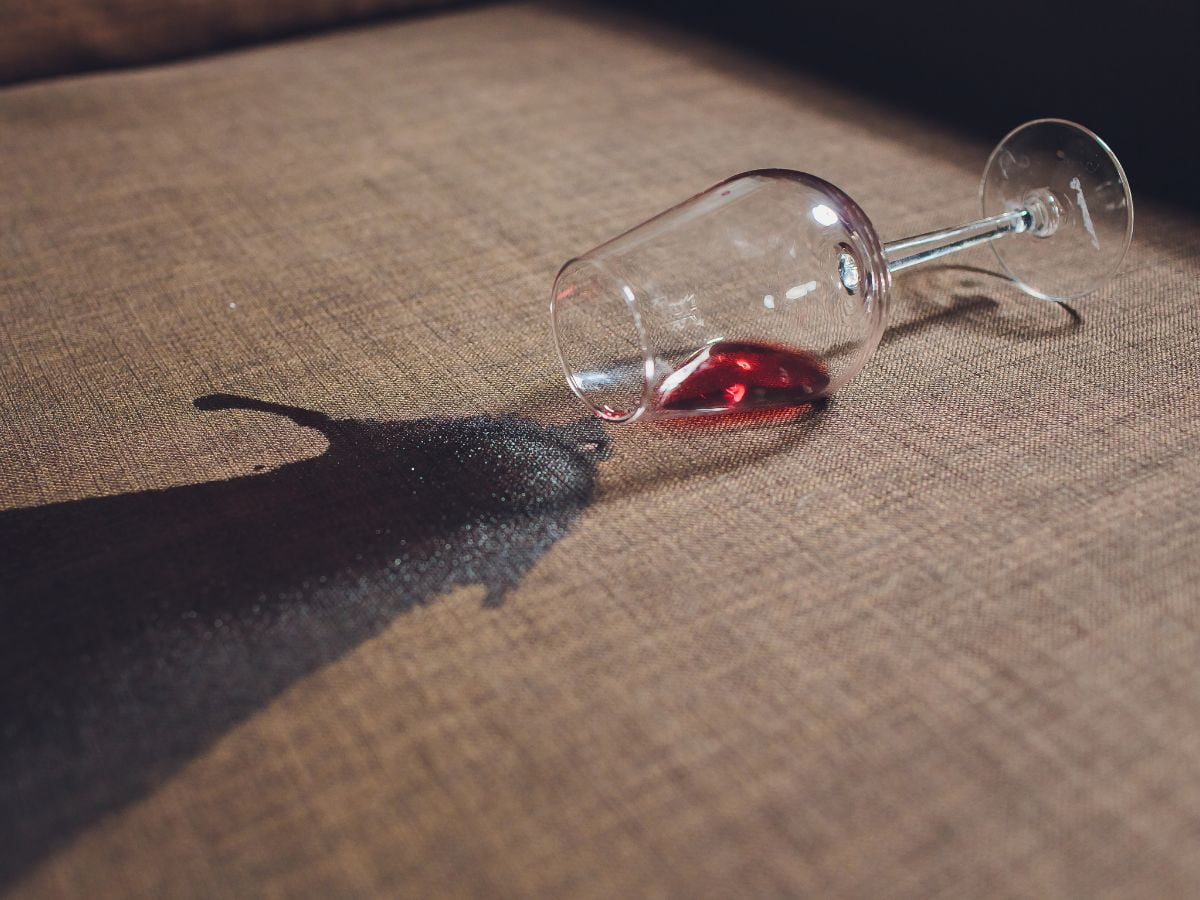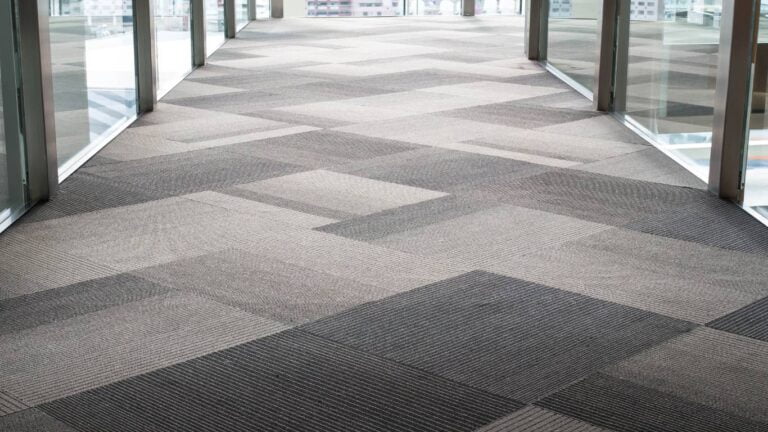Discovering how to get red wine out of a couch is essential for anyone who loves enjoying a glass of vino while lounging in their living room. A spill can happen to anyone, but there’s no need to let it sour your mood or your furniture. This article provides a comprehensive guide on tackling red wine stains swiftly and effectively, from quick home remedies to the use of specialised commercial cleaners. Whether you’re dealing with a fresh spill or a stubborn, dried-up blotch, you’ll learn various techniques and tips to help you restore your couch to its pre-accident condition. Plus, we’ll cover preventative measures to protect your upholstery from future mishaps, ensuring your relaxation time remains as carefree as it should be.
Immediate Response to a Red Wine Spill
Blot, Don’t Rub
When you accidentally spill red wine on a couch, the liquid starts soaking into the fabric’s fibres right away. It’s crucial to act fast, and your first move should be to blot the stain. Blotting is a gentle technique where you press a clean, dry cloth against the stain to soak up the wine.
This method is better than rubbing, which can spread the stain and push the wine deeper into the fabric, making it tougher to get out.
Importance of Acting Quickly
The secret to effectively handling a red wine spill is speed. As time ticks by, the wine begins to settle into the couch’s fibres, and the stain gets more stubborn.
If the wine dries, especially under heat, it undergoes a chemical change that bonds it to the fabric, which could make the stain permanent. So, it’s vital to tackle the spill before it dries to up your chances of getting it all out.
Gathering Necessary Supplies for Cleanup
To deal with a red wine spill, you need the right tools. Dry, absorbent materials are great for lifting the wine from the fabric. Everyday items like table salt, baking soda, or even talcum powder can be sprinkled generously onto the stain to absorb the wine.
You should let these substances sit for a few minutes to soak up as much as possible. Sometimes, if you’re quick enough, these alone might do the trick.
For tougher or bigger spills, you might need more help. A mix of three parts hydrogen peroxide to one part dish soap can be applied to the stain. Let it sit for up to an hour to do its thing.
After giving it time to work, blot the solution away carefully. Hot water can also help dilute and weaken the wine’s grip on the fabric, making it easier to blot away.
But remember, avoid using dry heat, as this can set the stain.
If you’re dealing with a dried stain, boiling water or an ‘oxi’ cleaner can come to the rescue. These cleaners have sodium percarbonate that turns into hydrogen peroxide when mixed with water, helping to break down and lift the stain.
It’s a good idea to have a couple of these cleaning solutions on hand at home. That way, you’re ready to jump into action if there’s a spill. By being prepared and moving quickly, you’ll seriously boost your chances of saving your couch from a red wine disaster.
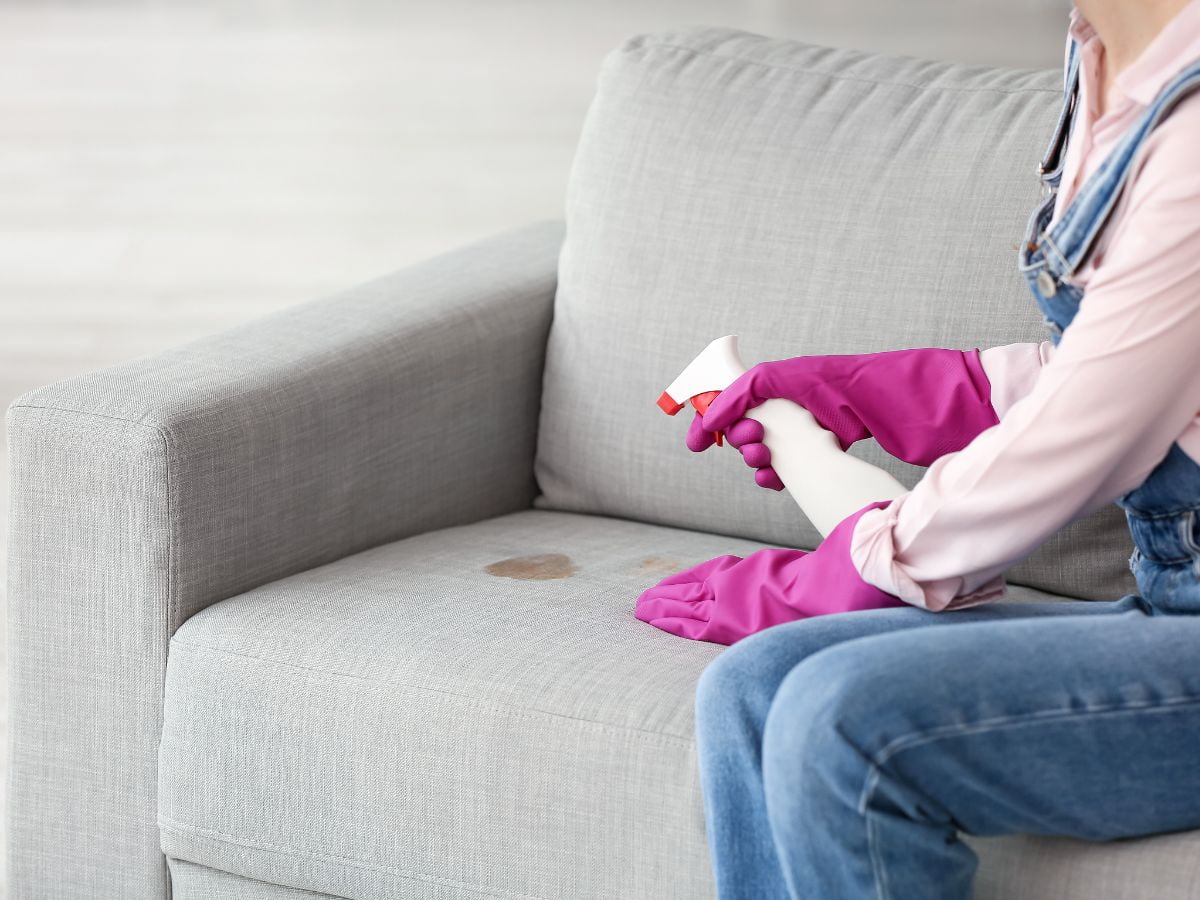
Home Remedies for Wine Stains
Using Salt to Absorb the Wine
After the initial blotting, applying a substantial amount of salt can be a practical step. It draws out the moisture and pigment from the upholstery. For more persistent stains, leaving the salt on the affected area for an extended period, even overnight, may be necessary. When it’s time, you can simply brush off the salt, potentially revealing a diminished or completely removed stain.
Applying Baking Soda Paste
For a different approach, you can create a paste from baking soda and water and spread it over the affected area. As it dries, it draws the discoloration out of the upholstery. Besides addressing the stain, baking soda also helps in eliminating any unwanted smells. After the paste has dried, vacuuming up the residue is straightforward, and any removable covers can be laundered as you normally would.
DIY Solutions: Vinegar and Dish Soap
Combining vinegar with dish soap offers another liquid option for tackling the stain. The acidity of vinegar works well to break down the stain, while the soap helps in removing the remnants. After applying the mixture and allowing it to sit, a damp cloth can be used to rinse the area. Regular vacuuming after the treatment will aid in restoring the upholstery’s original texture.
Before applying these methods, it’s wise to test them on a hidden area of your furniture to ensure they won’t cause any harm. With these eco-friendly strategies, you stand a good chance of rescuing your couch from the effects of the spill.
Commercial Cleaners and Their Use
Commercial cleaners, such as OxiClean Remover Powder, are specifically designed to address challenging stains like those from red wine. While they may not be as effective on different types of stains, their formulation is often potent enough to deal with both new and older wine marks.
Choosing the Right Wine Stain Remover
Selecting an appropriate cleaner involves considering the couch’s material and the specifics of the stain. Products like Emergency Stain Rescue Chateau Spill Red Wine Stain Remover are formulated for use on a variety of surfaces, including upholstery, and their non-toxic, biodegradable nature ensures they are safe around pets and children. Some stains may require more than one application for complete removal.
How to Safely Test a Cleaner on Your Couch
It’s essential to first test the cleaner on an inconspicuous part of the couch to ensure it doesn’t harm the fabric. Apply a small amount of the cleaner to a damp cloth and press it against the hidden area for a few minutes. Afterward, dry the spot quickly and check for any colour transfer or changes in the fabric’s appearance. If there’s any alteration, consider using a different product and avoid using harsh tools that could damage the upholstery.
Step-by-Step Guide to Using Commercial Products
Follow the instructions provided by the cleaner’s manufacturer for optimal results. Some may require dilution with water before application. It’s crucial to be aware of the potential health effects of certain cleaners, as they may contain chemicals that can cause respiratory issues or allergic reactions. Opt for products with lower levels of VOCs and fragrances, and ensure the space is well-ventilated during cleaning. The EPA’s Safer Choice list can be a resource for identifying less hazardous options. For minor stains, consider simple solutions like a mixture of warm water and soap.
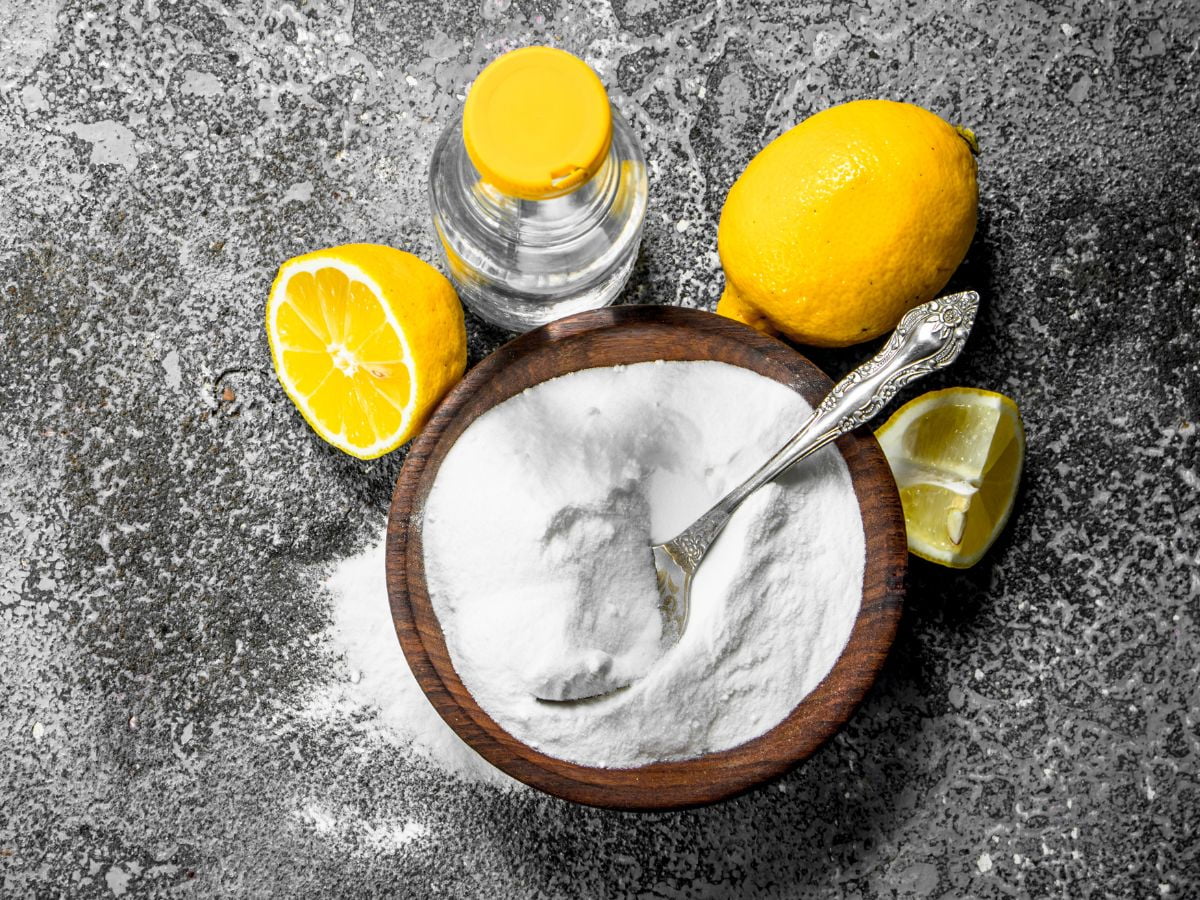
Natural Methods for Stain Removal
Lemon Juice and Cream of Tartar Blend
Another natural concoction involves lemon juice and cream of tartar. The acidity of lemon juice pairs with the mild abrasive quality of cream of tartar to tackle the stain. This mixture is particularly suitable for delicate fabrics that might be damaged by stronger chemicals.
Before using this blend, conduct a spot test on a hidden section of the couch to ensure it doesn’t cause any discoloration or damage.
The Role of Club Soda
Club soda is another household item that can be used for stain management. Its slight acidity and effervescence can help to break up and lift the wine molecules from the couch’s fabric.
Pour club soda directly on the stain and blot gently, taking care not to rub and spread the stain or damage the fabric. Acting immediately with club soda can help prevent the wine from setting into the fibres.
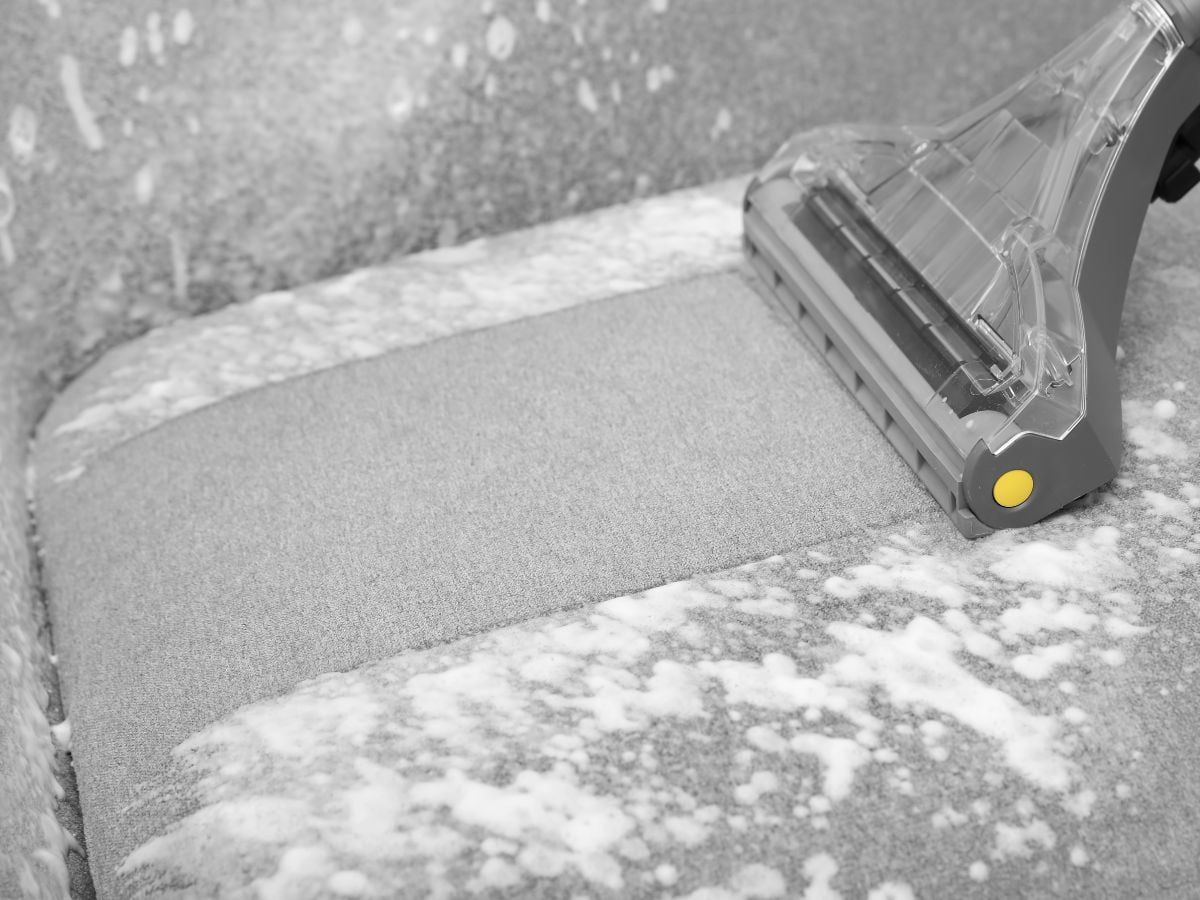
Using a Professional Upholstery Cleaning Service
While DIY methods can be effective, there are times when the expertise of a professional upholstery cleaning service is invaluable. Manufacturers often recommend professional cleaning every 12 to 24 months, but certain situations call for more immediate expert attention. If your furniture appears old, worn, or has persistent odours that home solutions can’t tackle, it’s time to consider a professional. This is especially true for challenging stains like red wine or when there’s a risk of damaging delicate upholstery with DIY methods. Professionals come equipped with specialised tools and techniques, such as hot water extraction and steam cleaning, which reach deep into upholstery fibres and effectively remove stains while sanitising the fabric. These services not only enhance the aesthetics of your furniture, restoring it to a like-new condition, but also improve indoor air quality by eliminating allergens. With professional cleaning, you get visibly superior results, time efficiency, and the peace of mind that your furniture is in expert hands, ensuring its longevity and maintaining your living space’s health and beauty.
View our stain removal services here.
Preventing Future Wine Stains
Tips for Stain-Proofing Your Couch
To safeguard your couch against future incidents, consider using an upholstery protector like Scotchgard. This can be particularly beneficial for materials that are more challenging to clean. The application process involves spraying the product evenly over the couch’s surface, ensuring full coverage without saturating any section excessively.
If you’re in the market for new furniture, inquire about sofas that come with a protective treatment already applied. For those that don’t, you can easily do it yourself, making sure to apply the protector uniformly. Even for pre-treated upholstery, it’s advisable to have the couch professionally cleaned annually and to reapply a fabric protector afterward to maintain its effectiveness.
Best Practices for Wine Drinking on Upholstery
Adopting certain habits can reduce the likelihood of spills. Regular maintenance, such as vacuuming with a brush attachment, can help maintain the fabric. Using a vacuum with a HEPA filter can trap allergens, improving indoor air quality. For spills, a simple solution of dish soap and distilled water can be effective. Adding white vinegar can enhance the cleaning power by cutting through grease and neutralising odours. For more stubborn stains, diluted hydrogen peroxide or clear alcohol may be used, and enzymatic cleaners are particularly effective for organic stains.
Regular Maintenance for Your Couch
To preserve your couch’s appearance and longevity, a deep-clean every three to six months is recommended, with more frequent vacuuming if pets are present. The frequency of maintenance may also depend on the colour of your sofa, with lighter shades needing more care. Regular cleaning addresses not only aesthetic concerns but also health-related ones, as it can prevent the proliferation of fleas, mould, and bacteria. Before any cleaning, it’s important to consult the couch’s care instructions to choose the appropriate method. For added protection, especially in homes with children or pets, consider using washable slipcovers or waterproof pads. An upholstery cleaner can be a more robust option for managing stains and odours. Following these practices can help ensure your furniture remains in good condition, even in the face of accidental spills.
A Final Thought on Wine Stain Woes
With the right approach and a bit of patience, even the most stubborn red wine stains can often be lifted from your beloved couch. Remember that swift action with the right tools and techniques is paramount for success.
For those moments when home remedies fall short or you’re dealing with delicate materials, don’t hesitate to reach out to professionals. Their expertise can save you time and prevent potential damage to your furniture.
Caring for your couch is not just about addressing accidents when they happen, but also about prevention and regular maintenance. By staying equipped and vigilant, you can enjoy your vibrant gatherings and peaceful evenings without the shadow of stain anxieties looming over you. Here’s to many more memorable moments on a spotless couch!

